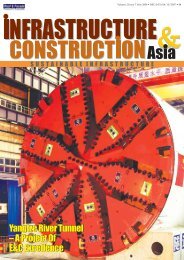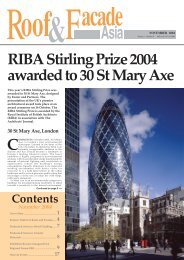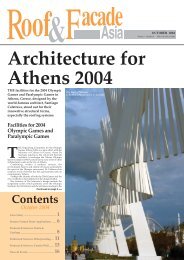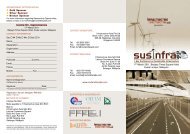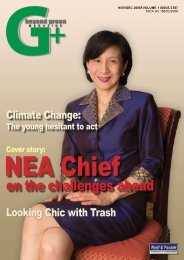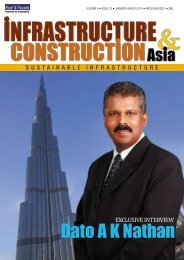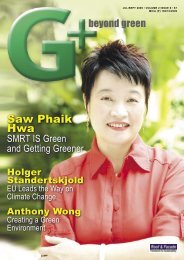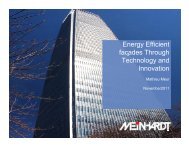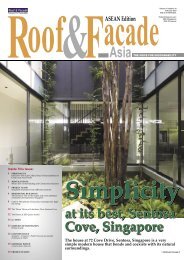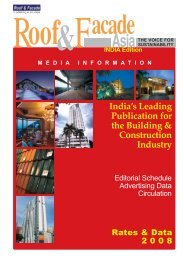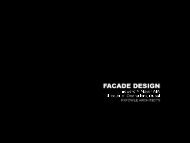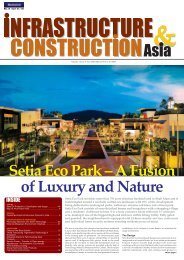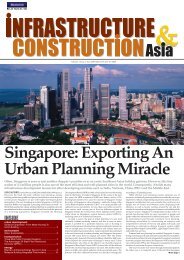p/Cover Story/Sep - Roof & Facade
p/Cover Story/Sep - Roof & Facade
p/Cover Story/Sep - Roof & Facade
You also want an ePaper? Increase the reach of your titles
YUMPU automatically turns print PDFs into web optimized ePapers that Google loves.
<strong>Roof</strong>&<strong>Facade</strong> Asia Feature: Translucent & Transparent Materials<br />
ETFE in Membrane Constructions<br />
– Important aspects of ETFE<br />
cushion structures<br />
Mr Dieter Linke, covertex GmbH / Engineering + Design GbR, Germany, highlighted the<br />
potential for the use of ETFE (ethyl tetra fluoro ethylene) cladding in the building industry, in<br />
his presentation at FLUOROPLAST 2004 World Congress which addressed the theme<br />
‘Fluoropolymers in Architecture - Construction – Design – Engineering’. The event, held on 28<br />
and 29 April 2004 in Zurich, Switzerland, was organised by Maack Business Services of Zurich.<br />
(The next FLUOROPLAST World Congress will be held in Zurich from 14 to 15 March 2006).<br />
Introduction<br />
Traditional architectural membranes are coated fabrics.<br />
Wind and snow loads are carried by the fabric.<br />
The coating protects the fabric against environmental<br />
impacts and it allows for the weld assembly of<br />
the panels.<br />
These membranes with PE-fabric and PVC<br />
coating or glass fibres with PVC coating are light<br />
and very strong – but never transparent.<br />
Typical characteristics of ETFE are its<br />
transparency (also combined with printing), natural<br />
light transmittance for visible light and UV-rays, its<br />
low weight and the possibility to build extended and<br />
variable curved surfaces in one piece. These<br />
characteristics make it very interesting for<br />
architectural purposes.<br />
But as ETFE membranes in roofing and cladding<br />
are not reinforced, they have to carry the loads<br />
without fabric. Thus, ETFE membranes have only a<br />
fractional amount of tensile strength, compared to<br />
coated fabric materials.<br />
It is obvious that the supporting structure and<br />
the detailing for the ETFE attachment must take this<br />
fact into account. A good way to do so, is to use ETFE<br />
in claddings as air supported cushions.<br />
It is a great challenge to merge the architect’s<br />
intentions with the special needs of ETFE<br />
structures, in order to achieve a good, durable and<br />
economic building.<br />
But to do so, knowledge about the less obvious,<br />
4 <strong>Roof</strong> & <strong>Facade</strong> Asia • <strong>Sep</strong>tember 2004<br />
though very important technical aspects relating to<br />
the use of ETFE as a structural element in buildings,<br />
is required, too. As building with ETFE has very<br />
little history, principals, architects, and engineers<br />
usually are not aware of the sometimes very rigid,<br />
boundary conditions.<br />
Depending on the type of supporting structure<br />
and the physical needs of the cladding, like thermal<br />
insulation, shading, and internal humidity, two<br />
main design groups can be identified - ETFE<br />
cushions and mechanically prestressed ETFE in a<br />
single layer.<br />
First, important aspects about ETFE cushions will<br />
be highlighted. Against this background, the special<br />
design features of the world’s largest ETFE cushion<br />
project, Allianz Arena Soccer Stadium, Munich, will<br />
be explained, and towards the end, the prospects<br />
with single layer ETFE constructions, will be<br />
discussed.<br />
Typical configuration of ETFE cushions<br />
ETFE cushions basically consist of one inner and one<br />
outer foil. Both are stabilised by automatically<br />
controlled, moderate, overpressure of the air<br />
trapped between them. This pressure is retained by<br />
fans. The layers are usually welded together along<br />
the edges and attached to the support structure with<br />
special aluminium extrusions.<br />
Static mode of operation<br />
Inward-aimed external loads (wind pressure, snow),<br />
are led to the inner foil by the internal overpressure.<br />
It carries the load, hammock-like.<br />
Outward-aimed external loads (wind suction) are<br />
carried by the outer layer in similar manner. Internal<br />
pressure and external wind suction add up to a<br />
Allianz Arena Soccer Stadium, Munich, Germany: The world’s<br />
largest ETFE cushion project.<br />
certain extent and need to be calculated carefully.<br />
The overpressure usually amounts to 250 Pa and<br />
can be changed up to the equivalent snow load, if<br />
necessary.<br />
Owing to the instability in windy conditions, a<br />
lack of air pressure should be avoided. If water<br />
ponding is excluded by well designed slopes on the<br />
roof, a lack of air pressure is usually not a static<br />
danger. The foils are designed for the expected loads<br />
and it is not important, whether, for example, snow<br />
load effects are applied to the inner layer via air<br />
cushion or applied directly.<br />
EXTERNAL LOAD E.G. SNOW<br />
HORIZONTAL<br />
SUPPORT<br />
REACTION<br />
INTERNAL OVER PRESSURE<br />
VERTICAL<br />
SUPPORT<br />
REACTION<br />
RADIUS OF OUTER FOIL<br />
OUTER<br />
INNER<br />
RISE<br />
OF<br />
ARCH<br />
Limited strength of ETFE foil<br />
The performance of a cushion-carrying load is<br />
dependent on the deployed thickness of the foil<br />
which is usually between 150 and 250 microns and<br />
on its radius of curvature. With typical building<br />
code design loads, the free span of a long,<br />
rectangular ETFE cushion, can reach up to<br />
approximately 4 m. Its length is limited only by<br />
practical considerations.<br />
High tension forces at the attachment structure<br />
and/or the space for the dip, must be taken into<br />
account. A radius of 3.5 m to 4 m for the curvature<br />
of a cushion layer between the attachment lines, is<br />
a good value to start with, for the design. A small<br />
radius reduces stress but increases the rise of the<br />
arch of the cushion foils.<br />
Supported with cable nets, to reduce the static<br />
free span of the foil, ETFE cushions have been built<br />
with up to 50 m in diameter.<br />
Safe air supply<br />
The normal excess pressure of 250 Pa equals 0.0025<br />
bar or 0.25 kN/sqm. The surplus amount of air<br />
required to provide this pressure in the cushion, is<br />
only a few litres. The air to fill the cushions and to<br />
replace losses, is led into the cushions via pipes and<br />
hoses, and is usually taken from outside of the<br />
building.<br />
Except under extremely windy conditions or<br />
when there is a danger of water ponding, the air<br />
overpressure in the cushion is not a vital element in<br />
the static performance of the cushions. But lack of<br />
air pressure could have negative effects on inner<br />
foils, internals, thermal insulation and durability of<br />
the entire construction.<br />
Usually, two electric engines with two fans (not<br />
Continued on page 5 >>>




